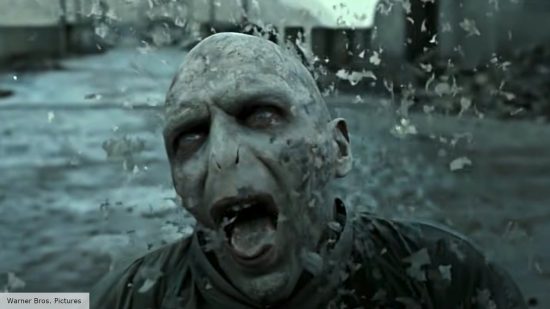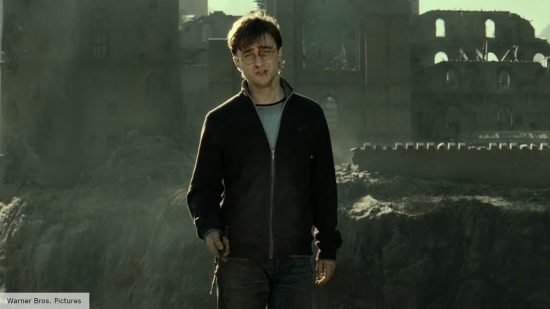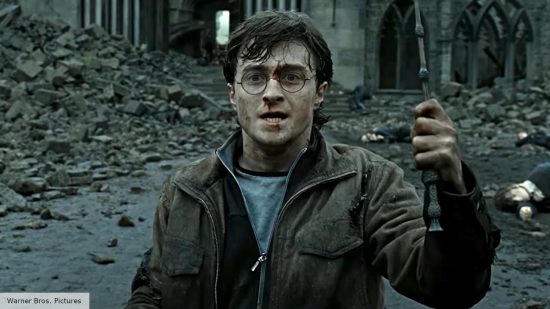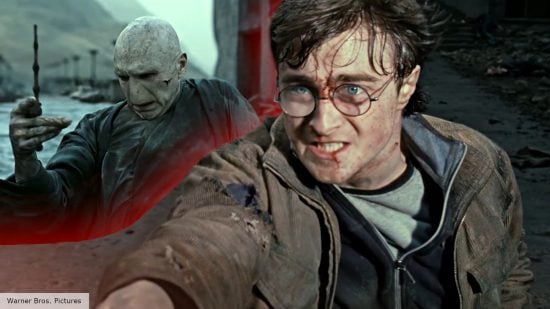I don’t buy into the argument that David Yates ruined Harry Potter. Sure, the movies he directed don’t have the colorful pomp of Christopher Columbus or the artful darkness of what Alfonso Cuaron did with Prisoner of Azkaban, but there’s a lot to like about them – and especially the titanic war movie that Deathly Hallows Part 2 became. That is, except for one outrageous misstep.
The process of adapting Harry Potter was always going to be an unenviable task, wrangling the massive Harry Potter cast while ensuring that book readers had enough of the best Harry Potter characters to keep them happy. If you go back and watch the Harry Potter movies in order, you can see just how impressive they are as a book-to-film translation.
As a two-part finale, Deathly Hallows gives us some of the franchise’s best movies. The first half is more contemplative and character-based, while the second provides frenetic action, mammoth spectacle, and mimics the anything-can-happen stakes that made it so entertaining on the page. But then it makes a giant goblin’s ear of the most important moment: the death of Voldemort.
By the time he has his final face-off with Harry, Voldemort is barely human. The creation of Horcruxes has irredeemably fractured his soul, and he has been twisted into a being of pure rage by his failure to conquer the Elder Wand prior to the death of Severus Snape.

Then, in the books, he gets a deliciously theatrical lecture on wandlore from Harry, learning that Draco Malfoy – another one of the best Harry Potter villains – was the true master of the Elder Wand until Harry won it from him. A few seconds and an explosion of the best Harry Potter spells later, old villainous Voldy meets a grubby end.
As the book puts it: “Tom Riddle hit the floor with a mundane finality, his body feeble and shrunken, the white hands empty, the snake-like face vacant and unknowing. Voldemort was dead, killed by his own rebounding curse, and Harry stood with two wands in his hand, staring down at his enemy’s shell”.
Brutal. Pathetic. Human. Compare that to this…

For reasons best known to Yates, writer Steve Kloves, and the rest of the team, Voldemort ended up with a death scene in which it looked like he had been snapped out of existence by Thanos. From a purely visual perspective, it’s understandable. A shower of ash is far more cinematic than a snake-like dude slumped in the corner of a room, but it robs the scene of its stark power.
On the page, the author goes to great lengths to convey how human Voldemort looked at the end. His body is “feeble”, the finality is “mundane”, and Harry looks down at his “shell”. Tom Riddle tried to make himself immortal and legendary, a vessel for the darkest of magic, but in the end, he died just like the rest of us.
That feeling is crucial to Voldemort’s defeat. In the movie, Voldemort’s dramatic goodbye – also afforded, bizarrely, to Bellatrix Lestrange – gives him a version of what he wanted. Sure, his desire for immortality didn’t pan out, but he did get to end his life as a mythic figure who achieved such depths of dark magic that he could not simply die like an ordinary man. He died more like a fallen Jedi than a defeated despot.

Voldemort’s death on the page has an echo of how the real world’s historic villains have been reduced, in their dying moments, to fragile and breakable human beings. In the book, it’s a clear evocation of his greatest failure – he never became more than anybody else, however many Horcruxes he made and whichever wand was in his hand.
The scene in Yates’ movie also robs us of Voldemort truly understanding the humiliating reason for that failure. In the book, Voldemort and Harry’s final confrontation takes place in the Great Hall in front of hundreds of witnesses from both sides of the battle, while Harry lays out the ownership of the Elder Wand and explains why Voldemort has got everything completely wrong.
Before a curse has even been aimed, the scene works beautifully. Voldemort’s arrogance crushes against Harry’s gallantry, with the Dark Lord digging his hole deeper and deeper until he unleashes the Killing Curse that ultimately rebounds upon him. His death is an intellectual defeat rather than a physical one, played out in front of Voldemort’s friends and foes alike. It’s as embarrassing as it is final – a defeat in every conceivable way.
On the screen, however, the duel plays out in an otherwise empty courtyard, and Harry only hints at Voldemort’s mistake with the wand. In fact, it’s only Ron and Hermione who get the full story about Malfoy and the wand’s true loyalty. Presumably, everybody else thinks Harry is just an absolutely godly purveyor of the Expelliarmus charm.

Yates and the team behind the movie seem to have fundamentally misunderstood every facet of why that final confrontation works. The entire point of it is that it’s a simple conclusion at the end of an enormous combat sequence reminiscent of the best war movies – a mark of Voldemort’s insurmountable pride and complete lack of magical understanding.
The argument, I suppose, would be that such a spectacular movie needs an equally spectacular conclusion. But it’s not as if the movie is short on noise, color, and conflict. In fact, the juxtaposition might have been even more stark and potent after two hours of whizz-bang spells and magical creatures tearing at each other’s flesh.
More than a decade on, Voldemort’s death remains the most infuriating misstep in the Harry Potter movie franchise. Yates played an absolute blinder with his final chapter, but he scribbled all over the final page like he’d been hit with a Confundus Charm. And much like Voldemort’s love for the words Avada Kedavra, that’s unforgivable.

For more fun from the Potter world, find out why this Harry Potter monster was too terrifying for the movies and learn more about Luna Lovegood, Dumbledore, Hagrid, and Grindelwald. We’ve also unveiled the secret inspiration behind the Deathly Hallows symbol.
The creator of the Harry Potter series, JK Rowling, has made a number of transphobic remarks on social media in recent years. If you’d like to learn more about transgender equality or lend your support, here are two charities we encourage you to visit: the National Center for Transgender Equality in the US and Mermaids in the UK.
